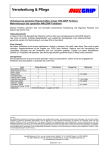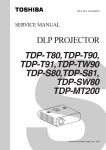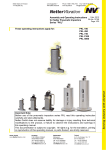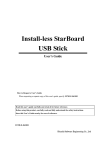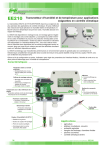Download H4204 User`s Manual
Transcript
IWILL® H4204 SERIES™ 4-Way Server System Hardware Installation Guide FB21201600 1 Preface Operation is subjected to the following two conditions 1. This device may not cause harmful interference 2. This device must accept any interference received, including interference that may cause undesired operation. IWILL® Corp. makes no warranty of any kind with regard to this material, including, but not limited to, the implied warranties of merchantability and fitness for a particular purpose. IWILL® Corp. shall not be liable for errors contained herein or for incidental or consequential damages in connection with the furnishing, performance, or use of this material. ® IWILL Corp. assumes no responsibility for the use or reliability of its software on equipment that is not ® furnished by IWILL Corp. This document contains proprietary information that is protected by copyright. All rights are reserved. No part of this publication may be reproduced, transcribed, stored in a retrieval system, translated into any language or computer language, or transmitted in any form whatsoever without the prior written consent of IWILL® Corp. © ® Copyright 2005 by IWILL Corp. All rights reserved. Other products and companies referred to herein the trademarks or registered trademarks of their respective companies or mark holders. The information in this document is subject to change without notice. 2 FCC Compliance Statement This equipment has been tested and found to comply with limits for a Class B digital device, pursuant to Part 15 of the FCC rules. These limits are designed to provide reasonable protection against harmful interference in residential installations. This equipment generates, uses, and can radiate radio frequency energy, and if not installed and used in accordance with the instructions, may cause harmful interference to radio communications. However, there is no guarantee that interference will not occur in a particular installation. If this equipment does cause interference to radio or television equipment reception, which can be determined by turning the equipment off and on, the user is encouraged to try to correct the interference by one or more of the following measures: 1. Reorient or relocate the receiving antenna 2. Move the equipment away from the receiver 3. Plug the equipment into an outlet on a circuit different from that to which the receiver is connected 4. Consult the dealer or an experienced radio/television technician for additional suggestions You are cautioned that any change or modifications to the equipment not expressly approve by the party responsible for compliance could void your authority to operate such equipment. This device complies with Part 15 of the FCC Rules. CE Compliance Statement Notice for Europe (CE Mark) This product is in conformity with the Council Directive 89/336/EEC, 92/31/EEC (EMC). 3 Table of Content CHAPTER 1 GETTING STARTED ........................................................................................... 6 1-1 PACKING LIST ..................................................................................................................... 7 1-2 PRODUCT SKUS .................................................................................................................. 7 1-3 OPERATING ENVIRONMENTAL REQUIREMENTS ..................................................................... 7 1-4 THE COMPLETE COMPONENTS OF H4204 SERIES............................................................... 8 1-5 BEFORE POWERING ON THE SYSTEM FOR THE FIRST TIME ..................................................... 8 1-6 ACTIVATING THE SYSTEM .................................................................................................... 9 1-7 ON LAST CHECK .................................................................................................................. 9 CHAPTER 2 SYSTEM OVERVIEW ........................................................................................ 10 2-1 H4024 SEVER SYSTEM BLOCK DIAGRAM ........................................................................... 11 2-2 H4204 SEVER SYSTEM OVERVIEW & SPECIFICATION ......................................................... 12 2-3 QUAD OPTERONTM PROCESSOR BOARD LAYOUT ............................................................... 14 2-4 MODULAR I / O BOARD LAYOUT ......................................................................................... 15 2-5 FRONT BOARD LAYOUT ..................................................................................................... 16 2-6 FAN BOARD & BMC CARD LAYOUT ................................................................................... 16 CHAPTER 3 SYSTEM INSTALLATION ............................................................................... 188 3-1 INTRODUCTION OF THE NECESSARY PARTS........................................................................ 19 3-2 INSTALLATION PROCEDURES ............................................................................................. 20 CHAPTER 4 HARDWARE INSTALLATION .......................................................................... 22 4-1 HARDWARE INSTALLATION PROCEDURES ......................................................................... 222 4-2 JUMPER SETTING OF QK8S MAINBOARD ......................................................................... 233 4-2.1 Front Panel Switch Header...................................................................................... 24 4-2.2 Clear CMOS Header................................................................................................ 25 4-2.3 VGA Jumper ............................................................................................................ 26 4-2.4 USB 1.1 Ports and Header .................................................................................... 266 4-3 JUMPER SETTING FOR MODULAR IO BOARD........................................................................ 27 4-4 INSTALL MEMORY ............................................................................................................. 28 4-4.1 Memory Installation Procedures .............................................................................. 29 4-5 INSTALL CPU ................................................................................................................... 31 4-5.1 CPU Installation Procedures.................................................................................... 31 4-6 INSTALL CPU HEATSINK ................................................................................................... 33 4-7 EPS POWER SUPPLY ....................................................................................................... 34 4-8 INSTALL EXPANSION CARDS .............................................................................................. 35 4-8.1 Expansion Card Installation Procedure ................................................................... 35 4 4-8.2 Assigning IRQs for PCI Expansion Cards ............................................................... 36 4-9 HTX PRO TECHNOLOGY .................................................................................................. 36 4-9.1 HTX Bridge Installation Guide ................................................................................. 36 CHAPTER 5 BIOS SETUP ..................................................................................................... 38 5-1 STARTING BIOS SETUP .................................................................................................... 39 5-2 UPDATING BIOS SETUP .................................................................................................... 40 5-3 USING SETUP ................................................................................................................... 42 5-4 BIOS SUPPORTS FEATURES .............................................................................................. 44 5-5 MAIN MENU ...................................................................................................................... 45 5-6 ADVANCED MENU ............................................................................................................. 45 5-6.1 IDE Configuration Submenu .................................................................................... 46 5-6.2 Floppy Configuration Submenu ............................................................................... 47 5-6.3 Super I/O Configuration Submenu........................................................................... 47 5-6.4 Hardware Health Configuration Submenu............................................................... 48 5-6.5 ACPI Setting Submenu............................................................................................ 48 5-6.6 Hyper Transport Configuration ................................................................................ 49 5-6.7 Remote Access Configuration Submenu................................................................. 49 5-6.8 USB Configuration Submenu................................................................................... 50 5-6.9 Onboard Device Configuration ................................................................................ 50 5-6.10 The Advanced setting description.......................................................................... 51 5-7 PCI PNP MENU ................................................................................................................ 52 5-8 BOOT MENU ..................................................................................................................... 54 5-8.1 Boot Settings Configuration Submenu..................................................................... 55 5-9 SECURITY MENU............................................................................................................... 56 5-10 CHIPSET SETTINGS MENU ............................................................................................... 57 5-10.1 NorthBridge Chipset Configuration Submenu ....................................................... 57 5-10.2 ECC Configuration Submenu ................................................................................ 58 5-10.3 South Bridge Configuration Submenu ................................................................... 59 5-10.4 PCI-X Configuration............................................................................................... 60 5-11 POWER MENU ................................................................................................................ 61 5-12 EXIT MENU ..................................................................................................................... 62 CHAPTER 6 TECHNOLOGY SUPPORT ............................................................................... 63 5 Chapter 1 Getting Started Congratulations on your purchase of the H4204 server system. The H4204 server system supports up to sixteen memory DIMMs (four for each processor installed) accommodating up to 64 GB of memory capacity using registered PC3200/2700/2100 ECC DDR memory modules. The H4204 server system is designed for flexibility and expandability, which is achieved via a modular design. The H4204 server system includes one CPU main board, one I/O module board with two 64-bit/133MHz-expansion slots and two x16 PCI-express expansion slots by x8 PCI-express lanes, and one Hyper Transport bridge via HTX Pro technology to join the modules together. The H4204 server system also features with an advanced cooling system to guarantee reliability and performance. Getting Started Additional features such as onboard Broadcom® 5721 Gigabit Ethernet controllers and onboard ATI® RageXL video controller with 8MB external memory provide high system capabilities that meet a wide range of demanding server applications. 6 1-1 Packing list Remove all items from the box and make sure you have these following items: 1. H4024 server system 2. The IWILL® H4024 server system hardware installation guide 3. One power cord 4. Four CPU heat sinks 5. One set of system side rails 6. UMS user’s guide and installation CD 7. One bezel for covering front panel Please check the quantity of cables and module boards that assembled inside the H4204 system. Cable Board 1 x KVM cable 1 x QK8S Board 1 x BMC cable 1 x GEIO-E Board 1 x LAN cable 1 x HTCB Board 1 x USB cable 1 x BMC Card 1 x Power LED panel cable 1 x FCB Card 1 x Rear IO board cable 1 x CD-ROM backplane 1 x IDE cable for CD-ROM device IMPORTANT If there are any missing parts, please contact your retailer immediately. 1-2 Operating Environmental Requirements To ensure the reliability and performance of H4204 server, please maintain the operating environment described below: 1. The ambient operating temperature is 0°C to 40°C 2. The relative humidity of operation is 10% to 85% non-condensing. 7 Be aware of the airflow for H4024 server! The H4024 server system uses forced direct-airflow to cool the system. The above operating conditions should be maintained for reliable operation. In order to avoid conditions which may lead to overheating, please do not let heated exhausted air from other equipment enter: 1. The front of the rack or the cabinet 2. The access panels of the server. Leave your system in the shipping crate at its final destination for 24 hours in the environment where you will set it up. This is to prevent thermal shock and condensation. To minimize the chance of system failure, use the server within the optimal temperature and humidity ranges as follow: 1. The optimize ambient temperature of operating is required as 21°C to 23°C 2. The optimize relative humidity of operating is 45% to 50% non-condensing. 1-4 The Complete Components of H4204 Server System Description Model Name 2U Chassis 2U 4-way server chassis including 700W Power Main Board QK8S -- Quad OpteronTM Server Board Modular I/O board GEIO-E HTX Pro board HTCB IPMI Accessory BMC 1.5 Card 1-5 Before Powering on The System for The First Time H4204 is provided with 700-Watt power supply unit. Locate and connect the AC power cords to the system and an AC power source. There is one power unit in the right of H4204. Please see the below illustrations to install your power system. 8 NOTE As the figure 1, you must install the power cord into the power module before you powering on the system. Figure 1 1-6 Activating The System After connecting the power cord to the system and AC source, the system can be powered on by pushing the power on button show below. Turn On/Off Reset 1-7 One Last Check Before you power on the system for the first time, it is helpful to avoid any problem by performing one last check. Make sure AC power is installed and that no parts have dropped down into the system. 9 Chapter 2 System Overview This chapter covers the installation of the system, cabling and system layout. The system specification section will cover the most detail features for the CPU board, IO board, and chassis. This chapter also contains the specifications for the supported processors and memory required for this system. The cabling section will cover the connection and installation for the related devices such as the serial connector, D-sub 15-pin VGA connector, USB connectors, Ethernet Gigabit connectors, and PS/2 connectors on the back System Overview and front panels. 10 2-1 H4024 Server System Block Diagram AMD AMD Opteron Opteron CPU CPU AMD AMD AMD 8111 Opteron Opteron CPU CPU AMD 8131 AMD 8131 Nvidia 2050 BCM BCM 5721 5721 11 2-2 H4204 Server System Overview & Specification 5 9 12 8 6 11 4 7 3 10 2 1 700 W Power Supply Unit 2 2 x 3.5” SATA HDD and 1 x slim-type CD-ROM bay 3 IWILL BMC Card 4 GEIO-E IO Board 5 HTX Pro Board (HTCB) 6 QK8S Main Board 7 Front side cooling fan (shown Fan 10 in BMC) 8 Front side cooling fan (shown Fan 9 in BMC) 9 Front side cooling fan (shown Fan 8 in BMC) 10 Middle cooling fan (shown Fan 5 in BMC) 11 Middle cooling fan (shown Fan 4 in BMC) 12 Middle cooling fan 1 12 System Specification: CPU Type Support quad AMD Opteron TM processor 800 series Support dual core processor Memory Type Support total 16 ECC/REG SDRAM memory DIMMs Support DDR400/333/266 memory module Support 2rank/4rank memory module Support up to 64GB memory capacity Storage Support 2 x 3.5” SATA hot-swap HDD bays Support 1 x slim type CD-ROM bay Support 1 x slim type FDD bay IO Expansion Support 2 x PCI-Express X16 slots in X8 mode Support 2 x PCI-X 64bit 133/100MHz slots Support low profile add-on cards installation only System Cooling 3 x 8032 8000RPM fans in front 3 x 60xx xxxxxRPM fans in middle Power Supply 700W EPS 12V power Rear IO 2 x USB ports 3 x Ethernet ports ( one port for system management ) 2 x PS/2 ports 1 x COM port VGA ports x 1 Front IO 2 x USB ports Power on/off button Reset button 2 x LAN LED 1 x HDD LED System Dimension W: 19” x H: 3.5” x D: 28” 13 2-3 Quad OpteronTM Processor Board, QK8S Layout 2 1 2 1 3 3 4 2 1 2 5 1 6 7 9 88 10 10 1 AMD Opteron™ Processors 5 IDE Connector 9 HyperTransport connector 2 Reg. ECC SDRAM Only 6 Slim Type CD-ROM Connector 10 BMC Connector (connected with BMC card) 3 24-pin + 2 8-pin EPS Power 7 AMD 8111 IO Control Hub 4 AMD 8131 PCI-X Chip 8 SCSI port to I/O board Only 14 2-4 Modular I / O Board, GEIO-E Layout 1 15 2 3 4 5 8 14 13 12 11 10 8 9 7 6 7 6 9 1 HyperTransport connector 7 PCI-X 64bit 133/100Mhz slot 13 Two USB ports 2 10pin power connector 8 Broadcom 5721 GbE controller 14 Two PS/2 ports 3 4pin power connector 9 10/100/1000 GbE NIC 15 SCSI port to Mainboard Only 4 AMD 8132 tunnel chip 10 10/100 NIC for management 5 6 Nvidia nForce4 Pro 2050 chip 11 PCI-Express X8 in X16 slot 12 One VGA port One Com port 15 2-5 Front Board Layout 1 1 USB Port USB 1.1 has a maximum bandwidth of 12Mbs, providing a marked improvement in device transfer speeds between your computer and a wide range of simultaneously accessible external Plug and Play peripherals. You can connect or disconnect USB cables when the system is turned on. 2-7 Fan Board & BMC Card Layout In H4204, there’re two boards for system configuration. There is one fan board to provide the power and fan monitor function of H4204; another is one BMC card for system management utility. 1 2 3 4 5 6 7 8 7 Fan Board Layout 1 3pin fan connector 5 (Fan 6 shown in BMC) 2 3pin fan connector 3pin fan connector (Fan 10 shown in BMC) 6 Power connector of fan board (Fan 7 shown in BMC) 16 3 3pin fan connector SM Bus connector 7 (Fan 8 shown in BMC) 4 3pin fan connector (connected with BMC card) Jumper setting 8 (Fan 9 shown in BMC) 2 1 4 5 3 BMC Board Layout 1 NS PC87435 BMC chip 4 SM Bus connector (connected with fan board) 2 XILINX XC9536XL 5 BMC connector (connected with QK8S MB) 3 JTAG for BMC card debug 17 Chapter 3 System Installation This chapter mainly covers how to install your system, H4204, to your rack housing on the server room. It will describe how to install the slide rail. This section also introduces the necessary parts of rack-mount kit of H4024 server system. Refer to the following illustration for the H4024 server system installation. System Installation 18 3-1 Introduction of the Necessary Parts 2 x H4024 server system Mounting Channel 2 x Inner Rails 4 x “L” Shaped Bracket 1 x H4024 server system 19 3-2 Installation Procedures 1. Mount L shape and external rail to rack frame. 2. Assemble inner rail to chassis 3. Insert the chassis into cabinet 20 4. Finish the installation 21 Chapter 4 Hardware Installation This chapter covers processor and memory installation and hardware configuration. 4-1 Hardware Installation Procedures Installation procedures will be broken down into six major parts. Step 1: Jumper setting Step 3: Install AMD OpteronTM Processors Step 4: Attach cables to connectors Step 5: Install expansion cards Step 6: Connect AC power WARNING This H4024 server system contains sensitive electronic components that can be easily damaged by static electricity. Follow the instructions carefully to ensure correct Installation and to avoid static damage. Hardware Installation Step 2: Install memory (DDR memory modules) 22 4-2 Jumper Setting of QK8S Mainboard This section covers the jumper setting. Refer to the following illustration for the location of the jumpers. 1 Front Panel Switch Header 5 Clear CMOS Header 2 Case Intruder 6 Onboard 10/100 LAN Header 3 USB Header 7 LAN LED Header 4 VGA Jumper 23 4-2.1 Front Panel Switch Header Reset Button (2-pin RST) This 2-pin connector connects to the chassis-mounted reset switch for rebooting your computer without turning your power switch off and on. This is a preferred method of rebooting your system to prolong the life of your system’s power supply. Hard Disk Activity LED (2-pin HDD_LED) This connector supplies power to the chassis's HDD/IDE activity LED. Read and Write activity by devices connected to the Primary or Secondary IDE connectors will cause the front panel LED to light up. ACPI LED ACPI function allows the system to enter or resume from the Suspend mode. If your system chassis does not have this button, the same function may be performed from your OS; if it is supported. Power On Switch This switch connects to the system’s Power button allowing you to power on and off the system. You can configure the system to use the keyboard or mouse to power-on the system. You can also configure the system to respond to power restoration after a power outage occurs. These functions can be configured by making appropriate settings in the Integrated Peripherals submenu (“Super IO Device” field) of the BIOS. Speaker Connector This connects to the PC speaker installed in the system chassis. Power LED Connector This connector connects to the system’s Power LED. When the system’s power is on, this LED will light. 24 4-2.2 Clear CMOS Header The onboard button cell battery powers the CMOS RAM. It contains all the BIOS setup information. Normally, it is necessary to keep the jumper connected to pin1 and pin2 (Default) to retain the RTC data as shown below. To help the customer clear CMOS easily, there is one attached Clear CMOS cable inside the system. Please kindly refer to the attached file. Follow these instructions to clear the CMOS RTC data: 1. AC off. 2. Short pin2 and pin3 with a jumper for a few seconds. 3. Replace the jumper on pin1 and pin2. 4. Turn on your computer by pressing the power-on button. 25 5. Hold down <Delete> during boot and select either the <Load Optimal Defaults> or <Load Failsafe Defaults> option in the selection "Exit". Then re-enter BIOS setup to re-enter user preferences. Refer to Chapter 5 BIOS SETUP for more information. 4-2.3 VGA Jumper This header lets you set your VGA port function. You can choose enable or disable this function or not. 1-2 2-3 Enable Disable 3 2 1 4-2.4 USB 1.1 Ports and Header H4204 supports USB 1.1 ports. USB 1.1 ports locate at the front and rear panel both. USB 1.1 supports transfer rates of up to 12MB/s. 26 4-3 Jumper Setting for modular IO board 1 2 3 1 2 J1 Pin Header, the PCI-X speed for 3 J1 Pin Header, the clock buffer setting 1-2 133Mhz 1-2 test mode 2-3 100Mhz 2-3 normal setting (default setting) J2 Pin Header, the PCI-X speed for 1-2 133Mhz 2-3 100Mhz 27 4-4 Install Memory The system main board uses Dual Inline Memory Modules (DIMM). Two pair banks are available; each bank supports one CPU with Hyper Transport Technology. The memory DIMMs accommodates PC2100/2700/3200 (DDR266/DDR333/DDR400) and Double Data Rate Memory (DDR) memory modules in 128MB, 256MB, 512MB, 1GB, 2GB, and 4GB combinations. WARNING H4204 SERIES ONLY supports Registered DDR ECC memory. IMPORTANT The system main board has strict memory type and timing requirements. Before you purchase DDR (Double Data Rate) memory for using in the system main board, you should contact your local reseller for a recommend list of system memory that has been validated on this system. This H4204 server system supports only Registered PC3200 /2100 /2700 (DDR400/DDR333/DDR266) compliant modules. You must populate H0 DIMM modules 0~3 before the H1 DIMM modules 0~3. IMPORTANT To take advantage of the 128-bit interface, you must install DIMMs in pairs of two (2). DIMM slots DIMM0 and DIMM1 are paired, and slots DIMM2 and DIMM3 are paired. If you are only installing two DIMMS into a Memory Bank, it is recommended that you install them in slots DIMM0 and DIMM1 to get the full bandwidth. Two DDR Modules HO DIMM0, HO DIMM1 Four DDR Modules HO DIMM0, HO DIMM1, HO DIMM2, HO DIMM3 28 4-4.1 Memory Installation Procedures 1. Locate the DIMM modules The CPU and memory socket number IMPORTANT The above CPU sequences are the number of PCB silkscreen. The CPU sequences of BIOS and server management utility are different and shown in below block diagram. 29 CPU 3 CPU 2 CPU 1 CPU 0 2. Make sure the DIMM’s pins are facing down, and check that the pin arrangement on the memory module resembles the one pictured below. Memory module pin arrangement 30 3. Insert the module into the DIMM socket and press down evenly on both ends firmly until the DIMM module is securely in place. (The tabs of the DIMM socket will close-up to hold the DIMM in place when the DIMM is properly installed into the socket.) IMPORTANT Always populate H0 DIMM socket before installing memory modules in the H1 DIMM sockets. 4-5 Install CPU System main board accommodates AMD OpteronTM micro-PGA Socket 940 processors at 1600 MT (Mega Transfer per second). You can install either two or eight processors on H4204 SERIES. When you install more than one processor on one main board, please follow the correct CPU installation sequence. The correct CPU installation sequence is CPU0, CPU1, CPU2, and CPU3. You must insert a CPU into CPU socket 0 (CPU0) first before installing one in CPU socket 1 (CPU1). 4-5.1 CPU Installation Procedures Follow these instructions to install a CPU. 1. The socket locking lever must be raised (Pull out slightly, and then lift up). 31 2. Locate the pin 1 of the CPU socket and pin 1 of the CPU. (Marked by a triangular space at 1 corner of the CPU) 3. Lower the locking lever and latching it into the fully locked position. 32 4-6 Install CPU Heat Sink 1. Apply thermal grease to the top of the CPU. Please spread thermal grease evenly across the metal heat spreader of the CPU. 2. Mount the CPU heatsink to the top of the CPU and socket as shown in the following illustration. Secure to the motherboard 3. The sequence for driving screws Please follow the number sequence to drive in four screws in order to fix the heat sink well. However, please DO NOT tightly drives in them before you finish all the procedures. 4. After you gently drive in all of screws, please keep the heat sink balance. Then, you can tightly drive in them. 5. If you feel the system is overheating, please shut down the system. Make sure whether the heat sinks fix well or not. Apply all of the thermal interface material to the center of the processor heater spreader plate. Gently put the heat sinks onto the top of CPU. Gently drive in the screws 33 NOTE Make sure that you use the heat-spreading paste between the Heat sink and the Integrated Heat Spreader of the processors. (Standard package includes one package of thermal paste.) 4-7 EPS Power Supply These 24-pin connectors connect the server board to the EPS power supply. Find the proper orientation and push down firmly to make sure that the pins are aligned. The 8-pin connector provides a dedicated power supply for the CPUs. 34 IMPORTANT ® IWILL always recommends our customers use EPS12V Power supplies. For any power damaged, please contact your retailer or IWILL® technicians. H4204 SERIES provides up to 700W from the power supply. This will support most hard drive and peripheral configurations. Always connect all power supply connectors to the motherboard (one 24-pin connector, two 8-pin connectors, one -12V connector, and one 10-pin connector) on main board and I/O board. 4-8 Install Expansion Cards WARNING Please power off your power supply completely when adding removing any expansion card or other system components. Failure to do so may cause severe damage to both your motherboard and expansion card. 4-8.1 Expansion Card Installation Procedure Read the documentation for your expansion card and make any necessary hardware or software setting changes such any jumper configuration. 1. Remove the bracket plate on the slot you intend to use. Keep the bracket for possible future use. 2. Carefully align the card's connectors and press with the riser card firmly. 3. Secure the card on the slot with the screw you removed above. 35 4-8.2 Assigning IRQs for PCI Expansion Cards An IRQ number is automatically assigned to PCI expansion cards. In the PCI bus design, the BIOS automatically assign an IRQ to a PCI slot that contains a card requiring an IRQ. To install a PCI card, you need to set the INT (interrupt) assignment. Since all the PCI slots on this motherboard use INTA #, set the jumpers on your PCI cards to INTA. 4-9 HTX PRO Technology The IWILL® H4204 SERIES consists of several separate boards to form a complete 4-Way AMD OpteronTM processor solution: Modularization of these three boards through IWILL’s HTX-Pro™ interfaces allows multiple possible configurations, each able to be optimized for size, thermal, performance or other considerations. The I/O board is connected to the CPU board via a HTX-Pro™ interface. The data between Mainboard and I/O board transfer via the HTX Bridge. The HTX Pro is a revolutionary design using the AMD64 Direct Connect Architecture to its full potential providing infinite possibilities in customization and unparalleled bandwidth access in I/O intensive applications. 4-9.1 HTX Bridge Installation Guide Please follow the below illustrations. You should firmly push the HTCB board into the connectors between modular IO board and main board. Front side of HTX Bridge 36 WARNING The wrong install direction will lead to system fail or harsh damage. 37 Chapter 5 BIOS Setup This chapter discusses the AMI BIOS Setup program built into the ROM BIOS. The Setup program allows users modifying the basic system configurations according to their requirements. This special information is then stored in battery-backed RAM so that it retains the Setup information when the power is turned off. The AMI BIOS installed in your computer system's ROM (Read Only Memory) is a custom version of an industry standard BIOS. The BIOS provides critical low-level support for standard devices such as disk drives and serial ports. The AMI BIOS has been customized by adding important, but non-standard, features such as password protection as well as special support for detailed fine-tuning of the chipset controlling the entire system. your system using Setup. BIOS Setup The rest of this chapter is intended to guide you through the process of configuring 38 5-1 Starting BIOS Setup The AMI BIOS is immediately activated when you power on the computer every time. The BIOS reads the system information contained in the CMOS and begins the process of checking out the system and configuring it. After finishing configuring the whole system, then BIOS will continue to seek an operating system on one of the disks, launch then turn control over to the operating system. While the AMI BIOS is in control, the Setup program can be activated in the way: By pressing the <DEL> key when the following message appears briefly at the bottom of the screen during the POST (Power On Self-Test). 39 5-2 Updating BIOS Setup Creating a bootable floppy disk A、 DOS environment Insert a 1.44 MB floppy disk into the drive. At the DOS prompt, type: format A:/S then press <Enter>. B、 Microsoft® Windows® environment Insert a 1.44 MB floppy disk into the floppy disk drive. From your Windows desktop, click on Start, then select My Computer. Select the 3 1/2 Floppy Drive icon. Click File from the menu, and then select Format. A Format 3 1/2 Floppy Disk window appears. If you are using Windows™, select “Create an MS-DOS startup disk” from the format options field, then click Start. Move the latest BIOS file to the bootable floppy disk. Using “AMIFLASH.EXE” to update the BIOS Update the BIOS using the AMIFLASH.EXE utility in DOS environment. 1. Visit the IWILL website ( http://www.iwill.net ) to download the latest BIOS file for your motherboard. Save the BIOS file to a bootable floppy disk. 2. At the DOS prompt, type the command line: AMIFLASH / <filename> where “filename” means the latest (or original) BIOS file that you copied to the bootable floppy disk. The screen displays the status of the update process. Important The BIOS information on the screen is for reference only. What you see on your screen may not be exactly the same as shown. Warning DO NOT shutdown or reset the system while updating the BIOS! Doing so may cause system boot failure! Make sure to set protection BIT disable before flash BIOS. 40 3. When the BIOS update process is complete, the utility returns to the DOS prompt. The AMI BIOS is immediately activated when you power on the computer every time. The BIOS reads the system information contained in the CMOS and begins the process of checking out the system and configuring it. After finishing configuring the whole system, then BIOS will continue to seek an operating system on one of the disks, launch then turn control over to the operating system. While the AMI BIOS is in control, the Setup program can be activated in the way: By pressing the <DEL> key when the following message appears briefly at the bottom of the screen during the POST (Power On Self-Test). Press <DEL> to enter SETUP 41 5-3 Using Setup In general, you use the arrow keys to highlight items, press <Enter> to select, press <Esc> to quit. The following table provides more details about how to navigate in the Setup program using the keyboard. Key Function Up Arrow( ) Key Move to the previous item Down Arrow( ) Key Move to the next item Left Arrow() Move to the previous item Key Right Arrow( ) Key Move to the next item Esc key In the Submenu: Exit the submenu. In the BIOS main category: Quit Without saving changes. Enter Key Select the item. A pop-up selection will display on the screen to set the item value. PgUp Key Previous page on Scrollable menus or jump to the first interactive item listed PgDn Key Next page on Scrollable menus or jump to the last interactive item listed F1 Key General Help on Setup navigation keys. Press <F1> key to pop up a small help window that describes the appropriate keys to use and the possible selections for the highlighted item. To exit the Help Window, press <ESC> key or <F1> key again. F2/F3 Key Change colors F7 Key Discard changes F8 Key Load failsafe defaults F9 Key Load optimal defaults F10 Key Save and Exit Home Go to top of screen End Go to bottom of screen Esc Exit 42 IMPORTANT The BIOS does NOT automatically save values that you have modified. If you do not save your values before you exit the BIOS Setup Utility, all your changes will be lost. If after making and saving system changes with the BIOS Setup Utility, you discover that your computer is no longer able to boot, the AMI BIOS supports an override, which will reset your system to the Failsafe defaults. If that fails, it is possible to manually clear the present CMOS information through the "Clear CMOS Header" on the motherboard (Refer to Jumper Settings for more information). The best advice is to ONLY alter settings which you thoroughly understand. The default settings have been carefully chosen by AMIBIOS to provide the maximum system performance and reliability. Even a slight change to the chipset setup may cause potential and unpredictable failure to the system. 43 5-4 BIOS supports features • Multi-processor (8 cores) • BBS POPup Boot • SMI (System Management Interface) • Complete Plug-and-Play options • PCI 2.3, PCI-X • ACPI 1.1 & 2.0 • APM1.2 • ATA 66 & 100 &133 • USB 2.0 • 48-bit LBA • Quick boot support • Console Redirection • Event logging • BIOS flash Protect • Multi-Level password • Hardware Monitor • Bad DIMM detection & re-mapping (chipset dependent) • SMBIOS 2.3.3 or EBDA logging and reporting • ECC Memory Detection • PXE 2.1 44 5-5 Main Menu This is the first screen that is displayed when you enter the BIOS Setup Utility. Each tab lined on the top of the screen represents each different menu. The following picture shows the main menu. Main menu shows the information of BIOS version, date and ID; processor type, speed and count; system size. In addition, system time and date is adjustable using + / - key or number keys. 5-6 Advanced Menu You can make these modifications on the advanced menu. 45 5-6.1 IDE Configuration Submenu You can make the selections on IDE Configuration menu. Feature Options Description OnBoard PCI IDE Controller Disable Disable: disable the integrated IDE controller Primary Secondary Both Primary: enable only the Primary IDE controller Secondary: enable only Secondary IDE controller the Both: enable both IDE controllers Hard Disk Write Protect Disable Enable Disable/Enable the hard disk write protection. This will be effective only device is accessed through BIOS IDE Detect Time out (sec) 0, 5, 10, 15, 20, 25, 30, 35 Select the time out value for detecting ATA/ATAPI device ATA (PI) 80Pin Cable Detection Host & Device Host Select the mechanism detecting 80 pin cable for Device 46 5-6.2 Floppy Configuration Submenu 5-6.3 Super I/O Configuration Submenu 47 5-6.4 Hardware Health Configuration Submenu IMPORTANT In the BIOS menu, you will not get the hardware health information because the BMC solution will take over this job and all information will be reported and shown in BMC section. 5-6.5 ACPI Setting Submenu 48 5-6.6 Hyper Transport Configuration To set up the hyper transport speed and bandwidth, you can adjust over this menu. The incorrect manipulation will impede the system running. 5-6.7 Remote Access Configuration Submenu 49 5-6.8 USB Configuration Submenu 5-6.9 Onboard Device Configuration You can make the selections on Onboard Device Configuration. Feature Options Onboard 1st Intel GIGA NIC Enabled Onboard 2nd Intel GIGA NIC Enabled Description Disabled Disabled 50 5-6.10 The Advanced setting description Feature Options Description Floppy Configuration Disabled Select Floppy A or Floppy B and then selects floppy-diskette type installed in your system. Hardware Health Configuration Disable/Enable 5 1/2” 360 KB 5 1/2” 1.2 MB 3 1/2” 720 KB 3 1/2” 1.44 MB 3 1/2” 2.88 MB hardware health function and hardware thermal throttling Enable/Disable health function hardware Thermal throttling allows the user to reduce CPU duty cycle to a user defined percentage when the temperature reaches a user defined value H/W health event ACPI Configuration ACPI Aware O/S Enable: O/S supports ACPI Yes/No Disable: O/S doesn’t support ACPI Hyper Transport Configuration CPU0 : CPU1 HT Link Speed/Width Hyper Transport speed/width is adjustable Remote Access Configuration Disable Selects Remote Access type USB Configuration Legacy USB Support Disabled/Enabled/Aut o Serial USB Mass Storage Device Configuration OnBoard Device Configuration link OnBoard SATA Controller / SATA Mode / INTEL NIC Enable / Disable Enable support for legacy USB Auto option disables legacy support it no USB device connected Configure the USB storage class devices mass N/A 51 5-7 PCI PnP Menu PCI PnP Menu 1 PCI PnP Menu 2 52 Feature Options Description Plug & Play O/S Yes Yes: lets the O/S configure PnP devices not required for boot if your system has a Plug and Play O/S No PCI Timer Latency Allocate IRQ to PCI VGA 32, 64, 96, 128, 160, 192, 224, 248 Value in units of PCI clocks for PCI device latency timer register Yes Yes: Assign IRQ to PCI VGA card if card requests IRQ No No: Doesn’t assign IRQ To PCI VGA cars even if card requests IRQ Palette Snooping Enabled Disabled PCI BusMaster IDE Offboard PCI/ISA IDE card Enabled Disabled Auto PCI Slot1 PCI Slot2 Enabled: informs the PCI devices that an ISA graphics device is installed in the system so the card will function correctly Enabled: BIOS uses PCI busmastering for reading/writing to IDE drives Some PCI IDE cards may require this to be set to the PCI slot number that is holding the card PCI Slot3 PCI Slot4 PCI Slot5 IRQ3~IRQ15 Available Reserved Available: specified IRQ is available to be used by PCI/PnP devices Reserve: specified IRQ is reserved for use by legacy ISA devices DMA Channel 0, 1, 3, 5, 6, 7 Available Reserved Available: specified DMA is available to be used by PCI/PnP devices Reserve: specified DMA is reserved for use by legacy ISA devices Reserved Memory Size Disabled 16K Size of memory block to reserve for legacy ISA devices 32K 64K 53 5-8 Boot Menu Feature Boot Priority Description Device Specify the boot device priority sequence Hard Disk Drives Specify the boot device priority sequence from available hard drives Removable Drives Specify the boot device priority sequence from available removable drives CD / DVD Drives Specify the boot device priority sequence from available ATAPI CDROM drives 54 5-8.1 Boot Settings Configuration Submenu Feature Options Description Quick Boot Disabled Allow BIOS to skip tests while booting Enabled Quiet Boot Disabled Disabled: Display normal POST messages Enabled Enabled: Display OEM logo Add-on ROM Display Mode Force BIOS Set display mode for option ROM Bootup Num-Lock Off Keep Current Select power on state for Num-Lock On PS/2 Support Mouse Disabled Select support for PS/2 mouse Enabled Wait for “ F1 “ if error Disabled Hit “ DEL “ Message Display Disabled Interrupt Capture Disabled 19 Enabled Enabled Enabled Wait for F1 key to be pressed if error occurs Display “ Press DEL to run Setup “ in POST Enabled: allows option ROMs to trap interrupt 19 55 5-9 Security Menu Feature Options Description Change Password User Install or change the password Clear Password User Setup: check password while invoking setup Always: check password while invoking setup as well as on each boot Boot Sector Virus Protection Disabled BIOS Protection Disabled Write Enable/Disable boot sector virus protection Enabled N/A Enabled 56 5-10 Chipset Settings Menu 5-10.1 NorthBridge Chipset Configuration Submenu Northbridge Chipset controls the system memory configuration. Although AMD processors integrate the memory control function, you could still configure memory setting on this BIOS menu. 57 5-10.2 ECC Configuration Submenu Feature Options Description Master ECC Enable Disabled Master ECC Enables support on all nodes for ECC error detect and correction Enabled 58 5-10.3 South Bridge Configuration Submenu Feature Options 2.0 SM Bus Controller Disabled Description Enabled HT Link 0 P-Comp Mode Auto HT Link 0 N-Comp Mode Data HT Link 0 RZ-Comp Mode Calcomp + Data Calcomp - Data Auto causes hardware compensation vales. Other choices allow the user to override default compensation with an absolute value, add to the hardware generated value, or subtract a value from the generated value 59 5-10.4 PCI-X Configuration Feature HT Link P-Comp Mode 0 Options Description Auto Auto causes compensation values. hardware Auto causes compensation values. hardware Auto causes compensation values. hardware Auto causes compensation values. hardware Auto causes compensation values. hardware Auto causes compensation values. hardware Data Calcomp+Data Calcomp-Data HT Link 0 N-Comp Mode Auto Data Calcomp+Data Calcomp-Data HT Link 0 NZ-Comp Mode Auto Data Calcomp+Data Calcomp-Data HT Link P-Comp Mode 1 Auto Data Calcomp+Data Calcomp-Data HT Link 1 N-Comp Mode Auto Data Calcomp+Data Calcomp-Data HT Link 1 NZ-Comp Mode Auto Data Calcomp+Data Calcomp-Data 60 5-11 Power Menu 61 5-12 Exit Menu Feature Save Changes and Exit Description Exit system setup after saving the changes F10 key can be used for this operation Discard Changes and Exit Exit system setup without saving the changes Discard Changes Discard changes done so far to any of the setup question ESC key can be used for this operation F7 key can be used for this operation Load Optimal Defaults Load optimal default values for all the setup questions F9 key can be used for this operation Load Failsafe Defaults Load Failsafe default values for all the setup questions F8 key can be used for this operation 62 Chapter 6 Technology Support If a problem arises with yours system during Installation or OS operating, you should ask your dealer for help first as your system has most likely be configured by them. They always have the best idea and quick response for your symptoms. If your dealer is near to your locations, you should bring your system to them to have it quickly serviced instead of attempting to solve the problem by yourself. 1. Go to IWILL® website at www.iwill.net and navigate to this product page which 2. FAQ sections on IWILL® Website are often helpful since other user's questions are often your own. 3. Technology Support contains links to product updates such as Jumper settings or BIOS updates. Email us at: [email protected] and we will try to answer your questions within 24 hours. Three years Warranty If any problems occur during the product’s warranty period, consult your system vendor or distributor before contacting IWILL®. The warranty covers normal customer use of the product. The warranty does not cover damages sustained during shipping or failure due to alteration, misuse, abuse, or improper maintenance of the unit. 63 IWILL® H4204 SERIES™ Server Hardware Installation Guide Document part number: FB21201600 Appendix A H4204 SERIES Server Standard Cables inside the Chassis One Front Board Cable One USB Cable One LED Signal Connect Cable One CD-ROM Cable One LAN Cable One SCSI Cable 64

































































